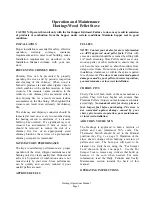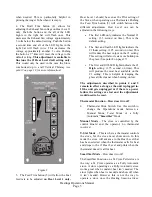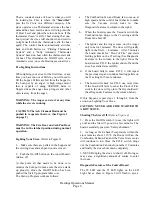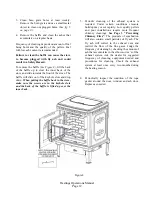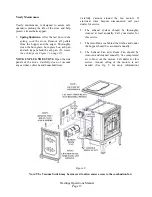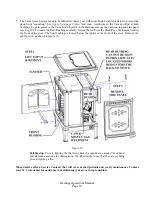
Hastings
Operations Manual
Page 8
THERMOSTAT
WIRE
TERMINAL
DAMPER
Combustion Air Damper
Figure 3
Damper Adjustment
When burning pellets make sure to check for
the formation of creosote in the unit and
venting system. Constantly running the stove
on a low setting with too much combustion air
may cause creosote to form. Burn pot
temperatures can be “too cool” when burning
on low with too much draft.
Adjusting the Damper may take a little time and
patience, but only needs to be done once. After
the damper has been adjusted to the venting
system in your home, the control board will do
the rest.
The purpose of this damper is to adjust
combustion airflow to match the characteristic of
each specific air inlet and chimney configuration.
There is a setscrew in the damper
(shown in
Figure 4)
and the damper has been preset at the
factory. This setting will most likely work for
90% of the most common installations. Long
horizontal runs might need the damper opened.
Tall vertical runs might need the damper to be
closed a little, etc. To adjust the damper, use the
setscrew to make the adjustments. To make an
adjustment turn the screw ½ turn clockwise to
open the damper or ½ turn counter clockwise to
close the damper. Remember to use the damper
handle to bring the damper up to the screw. The
damper will not close by itself. After making an
adjustment wait at least 15 minutes to see how
the burn pot reacts to the change.
Adjusting the
damper during the break in period is very
important (See “Preventing Chimney Fires” on
page 2)
. Break-in requires the burning of 15 bags of
pellets or continuous burn for two weeks. If during
the initial break-in period you experience difficulty
keeping the stove burning or there appears to be an
excessive amount of burning pellets being evacuated
from the burn grate, it may be necessary to close the
damper some more. Once the damper is fine tuned
for settings 1, 2, 3 and 4 the stove will run fine
without having to make a change to the damper
setting unless the stove is run on 5 for extended
periods of time. It is normal for ash and some sparks
to be continually evacuated from the burn grate. This
is how the grate continuously cleans itself. The
equivalent of a teacup of unburned pellets a day in
the ash pan is considered normal.
Figure 4
Flame Pattern Characteristics
Correct Flame Pattern -
Bright yellowish-white
flame with a brisk movement, having sharp pointed
end tips extending up towards the Heat Exchange
Tubes while forming a fan-like shape. Small
amounts of ash and some live sparks being blown
out from the Burn Pot area is considered normal
operation.
Incorrect Flame Pattern -
Dark orangish-brown
flame with a lazy movement, having black smoky
end tips curling up and over the Heat Exchange
Tubes while forming a fireball-like shape. Some Ash
or Live Sparks not being blown out from the Burn
Pot area is considered abnormal operation.
Extremely black soot forming on the ceramic glass
surface is a sign of very poor combustion (not
enough combustion air) and should not be
overlooked. At the other end of the spectrum; an




